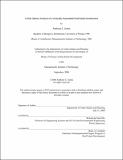A real options analysis of a vertically expandable real estate development
Author(s)
Guma, Anthony C. (Anthony Christian), 1975-
DownloadFull printable version (2.445Mb)
Other Contributors
Massachusetts Institute of Technology. Center for Real Estate.
Advisor
Richard de Neufville.
Terms of use
Metadata
Show full item recordAbstract
Like many great business ventures, grand successes in real estate development are often attributed to individuals with strong visions and talent, as well as a keen foresight on the future conditions which will ultimately decide the value of their projects. Even with the best forecasts and predictions, this type of a clear view of the future real estate market is typically difficult to bring into focus. By considering developments which provide the ability to react accordingly to the uncertainty of future forces, developers can better manage the risk associated with a potential weak market while also gaining the potential to benefit in a strong one. Flexibility of this type in real estate is generally known as a "real option." Even in dense urban centers with a limited amount of developable land, market uncertainty may still exist. Therefore, flexibility in that type of environment could allow a developer to be better positioned should a market improve or decline. One way to provide this type of flexibility on urban sites is to develop a given quantity of space initially with the option to add more vertically in the future. Although rare, such vertical expansions are quite feasible and the real option is quantifiable. This thesis investigates the value of providing a real option to vertically expand a structure in the future. Real option valuation is often regarded as a complex procedure and outside of typical real estate finance. This investigation will adopt a previously developed methodology based on familiar spreadsheet techniques and common valuation metrics such as net present value. To explore the use of this methodology and the potential value of vertical expansion, the Health Care Service Corporation headquarters in Chicago, IL is the basis of an analysis. This structure represents an existing building with the built-in option to expand vertically to almost twice its initial height.
Description
Thesis (S.M. in Real Estate Development)--Massachusetts Institute of Technology, Dept. of Urban Studies and Planning, Center for Real Estate, 2008. This electronic version was submitted by the student author. The certified thesis is available in the Institute Archives and Special Collections. Includes bibliographical references (p. 64-66).
Date issued
2008Department
Massachusetts Institute of Technology. Center for Real Estate; Massachusetts Institute of Technology. Department of Urban Studies and PlanningPublisher
Massachusetts Institute of Technology
Keywords
Urban Studies and Planning., Center for Real Estate.